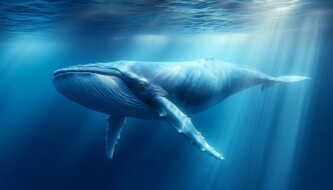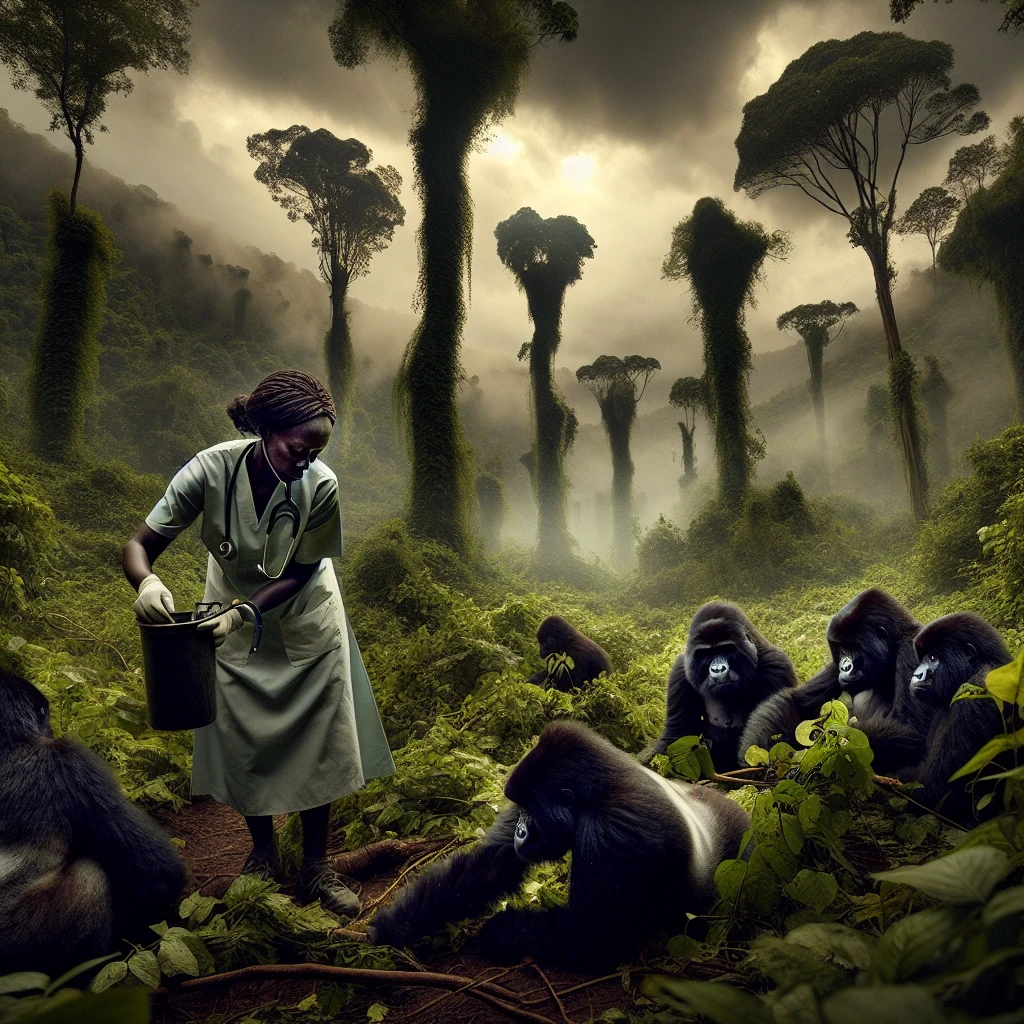Blue whales, which are the biggest animals on Earth, have come back to a part of the Indian Ocean where they were killed off by whaling in the past. In 2020 and 2021, scientists and filmmakers in the Seychelles recorded videos of the whales, suggesting that they might be breeding there. This is a big win for conservation because the blue whale population was greatly reduced by whaling in the 1960s. Blue whales are still in danger, with only a small fraction of their original numbers remaining. But finding them in the Seychelles is really exciting.
The scientists used special equipment to study the blue whales. They put a “sound trap” on the ocean floor near the Seychelles and left it there for a year, recording 15 minutes of every hour, every day. Even though they didn’t hear the blue whales during their trip, they found out from the recordings that the whales were there and making sounds during certain months, especially March and April. The scientists think that the Seychelles might be an important place for blue whales to have babies or raise their young.
The blue whale’s song is so deep and low that humans can’t hear it. But scientists can pick up on the higher-pitched sounds, called harmonics, that go along with the whale’s song. These harmonics make a low, deep, and steady beat that is the loudest sound made by any animal. Blue whales use these sounds to talk to each other over long distances in the water.
Conservation scientists want to know how important the Seychelles is for blue whales. The area around the islands has been protected, and the Seychelles government has promised to protect 30% of its national waters. This is really important for keeping safe areas for blue whales and other sea animals. Noise pollution from human activities is a big problem because it can mess up the way blue whales talk and behave. The Seychelles, with not a lot of ships passing through, could be a safe and quiet place for these amazing creatures.
Original news source: Blue whales: Ocean giants return to ‘safe’ tropical haven (BBC)
Listen
Slow
Normal
Fast
Group or Classroom Activities
Warm-up Activities:
– Charades
Instructions: Divide the class into small groups. Each group will take turns acting out different sea animals, including blue whales, for the rest of the group to guess. The students acting out the animal can only use gestures and actions, no words allowed. The group that guesses the most animals correctly wins.
– News Summary
Instructions: In pairs or small groups, have the students read the article and then summarize the key points in their own words. They should focus on the main idea, important details, and any interesting facts they find. Afterward, each group can share their summaries with the class.
– Opinion Poll
Instructions: Have the students form pairs or small groups. Give them a list of statements related to the article, such as “Protecting blue whales is important for marine conservation” or “Whaling should be banned worldwide.” Each student should choose whether they agree or disagree with each statement and provide reasons for their opinions. Afterwards, conduct a class discussion where students can share their opinions and debate the statements.
– Vocabulary Pictionary
Instructions: Write a list of vocabulary words from the article on the board. Divide the class into teams and have one student from each team come to the board. Give each student a word from the list and they must draw a picture to represent the word while their team tries to guess what it is. The team that guesses the most words correctly wins.
– Future Predictions
Instructions: In pairs or small groups, have the students discuss and make predictions about the future of blue whales in the Seychelles. They should consider factors such as conservation efforts, human activities, and the impact of climate change. Each group can then share their predictions with the class and discuss the likelihood of each scenario.
Comprehension Questions:
1. Why is the return of blue whales to the Indian Ocean considered a big win for conservation?
2. How did scientists study the blue whales in the Seychelles?
3. Why couldn’t the scientists hear the blue whales during their trip?
4. What are harmonics and how do they relate to the blue whale’s song?
5. Why do blue whales use sounds to communicate with each other?
6. Why is it important for the Seychelles to protect its national waters?
7. How can noise pollution from human activities affect blue whales?
8. Why do scientists think the Seychelles could be a safe and quiet place for blue whales?
Go to answers ⇩
Listen and Fill in the Gaps:
Blue whales, which are the (1)______ animals on Earth, have come back to a part of the Indian Ocean where they were killed off by whaling in the past. In 2020 and 2021, scientists and filmmakers in the (2)______ recorded (3)______ of the whales, suggesting that they might be breeding there. This is a big win for conservation because the blue whale population was greatly reduced by whaling in the 1960s. Blue whales are still in danger, with only a small fraction of their (4)______ numbers remaining. But finding them in the Seychelles is really exciting.
The scientists used special equipment to study the blue whales. They put a “sound trap” on the ocean floor near the Seychelles and left it there for a year, recording 15 minutes of every hour, every day. Even though they didn’t hear the blue whales during their trip, they (5)______ out from the (6)______ that the whales were there and making (7)______ during certain months, especially (8)______ and April. The scientists think that the Seychelles might be an (9)______ place for blue whales to have babies or raise their young.
The blue whale’s song is so deep and low that humans can’t hear it. But (10)______ can pick up on the higher-pitched (11)______s, called harmonics, that go along with the whale’s song. These harmonics make a low, deep, and steady beat that is the loudest sound made by any (12)______. Blue whales use these sounds to talk to each other over long distances in the water.
Conservation scientists want to know how important the Seychelles is for blue whales. The area around the islands has been protected, and the Seychelles (13)______ has promised to protect 30% of its national waters. This is really important for keeping safe areas for blue whales and other sea animals. Noise pollution from human (14)______ is a big problem because it can mess up the way blue whales talk and behave. The Seychelles, with not a lot of (15)______ passing through, could be a safe and quiet (16)______ for these amazing creatures.
Go to answers ⇩
Discussion Questions:
Students can ask a partner these questions, or discuss them as a group.
1. What is a blue whale and why are they important?
2. How would you feel if you saw a blue whale in person?
3. Do you like watching documentaries about animals? Why or why not?
4. Do you think it’s important to protect endangered species like the blue whale? Why or why not?
5. What do you think it means for the blue whales to be breeding in the Seychelles? Why is it exciting?
6. Have you ever seen a whale in real life? If so, how did it make you feel?
7. Why do you think the scientists used a “sound trap” to study the blue whales?
8. How do you think the Seychelles being a safe and quiet place can benefit the blue whales?
9. What do you think would happen if the blue whale population continued to decrease?
10. Do you think it’s important for governments to protect their national waters? Why or why not?
11. How do you think noise pollution can affect the way blue whales communicate?
12. Have you ever heard a sound that you couldn’t hear, but others could? How did it make you feel?
13. What do you think is the most interesting fact you learned about blue whales from the article?
14. How do you think the Seychelles government can ensure that the protected area remains safe for the blue whales?
15. If you were a scientist studying blue whales, what other questions would you want to find answers to?
Individual Activities
Vocabulary Meanings:
Match each word to its meaning.
Words:
1. blue
2. whales
3. Seychelles
4. breeding
5. recordings
6. sounds
7. conservation
8. pollution
Meanings:
(a) Reproducing and having babies
(b) Protecting and preserving the environment and wildlife
(c) The color of the sky or ocean
(d) A group of islands in the Indian Ocean
(e) Noises made by animals or objects
(f) The largest animals on Earth
(g) Capturing and saving information on video or audio
(h) Harmful substances or noise that can harm the environment
Go to answers ⇩
Multiple Choice Questions:
1. What is the main reason why blue whale populations were greatly reduced in the past?
(a) Pollution
(b) Climate change
(c) Overfishing
(d) Whaling
2. How did scientists study the blue whales in the Seychelles?
(a) By using drones to observe them from above
(b) By tagging the whales with GPS trackers
(c) By using a “sound trap” on the ocean floor
(d) By taking underwater photographs
3. What did the scientists discover from the recordings of the “sound trap”?
(a) The blue whales were present in the area during certain months
(b) The blue whales were not making any sounds in the Seychelles
(c) The blue whales were communicating with other species of whales
(d) The blue whales were breeding in the Seychelles
4. What is the loudest sound made by any animal?
(a) The chirping of a bird
(b) The roar of a lion
(c) The harmonics of the blue whale’s song
(d) The howl of a wolf
5. How do blue whales use their sounds to communicate?
(a) To talk to each other over long distances in the water
(b) To scare away predators
(c) To find food
(d) To attract mates
6. Why is the protection of the Seychelles important for blue whales?
(a) It offers an abundance of food for them to eat
(b) It provides a safe and quiet environment for them
(c) It allows them to migrate to other areas more easily
(d) It prevents them from being hunted by whalers
7. What is one of the main threats to blue whales in the ocean?
(a) Climate change and rising sea temperatures
(b) Noise pollution from human activities
(c) Lack of food due to overfishing
(d) Predation by sharks and killer whales
8. What is the current status of the blue whale population?
(a) They are thriving and their numbers are increasing
(b) They are no longer endangered and their population is stable
(c) Their population has completely recovered from past whaling activities
(d) Only a small fraction of their original numbers remain
Go to answers ⇩
True or False Questions:
1. The Seychelles’ protected area and commitment to preserving 30% of its national waters is insignificant for the safety of blue whales and other marine animals.
2. This is a significant conservation success as the blue whale population was greatly reduced by whaling in the past.
3. Blue whales are still endangered, with only a small fraction of their original numbers remaining.
4. Blue whales, the smallest animals on Earth, have returned to an area in the Indian Ocean where they were once hunted.
5. The scientists used ordinary equipment, including a “sound trap,” to study the blue whales in the Seychelles.
6. Although the scientists did not hear the blue whales during their trip, recordings revealed that the whales were present and making sounds during certain months.
7. Scientists and filmmakers in the Seychelles have failed to capture videos of the blue whales, suggesting they may not be breeding there.
8. The Seychelles may be an important location for blue whales to have babies or raise their young.
Go to answers ⇩
Write a Summary:
Write a summary of this news article in two sentences.
Check your writing now with the best free AI for English writing!
Writing Questions:
Answer the following questions. Write as much as you can for each answer.
Check your answers with our free English writing assistant!
1. What is the significance of the blue whales returning to the Indian Ocean?
2. How did scientists study the blue whales in the Seychelles?
3. What is the purpose of the “sound trap” used by the scientists?
4. How do blue whales communicate with each other?
5. Why is the Seychelles considered an important area for blue whales and other sea animals?
Answers
Comprehension Question Answers:
1. Why is the return of blue whales to the Indian Ocean considered a big win for conservation?
– The return of blue whales to the Indian Ocean is considered a big win for conservation because they were previously killed off by whaling. Their presence now suggests that their population is recovering, which is great news for their conservation.
2. How did scientists study the blue whales in the Seychelles?
– Scientists studied the blue whales in the Seychelles by using a “sound trap” placed on the ocean floor. This trap recorded 15 minutes of every hour, every day for a year, allowing the scientists to analyze the sounds made by the blue whales.
3. Why couldn’t the scientists hear the blue whales during their trip?
– The scientists couldn’t hear the blue whales during their trip because the blue whale’s song is so deep and low that it cannot be heard by humans. However, they were able to pick up on the higher-pitched sounds, called harmonics, which are associated with the whale’s song.
4. What are harmonics and how do they relate to the blue whale’s song?
– Harmonics are higher-pitched sounds that accompany the blue whale’s song. They create a low, deep, and steady beat, which is the loudest sound made by any animal. Scientists can pick up on these harmonics to study and analyze the blue whale’s communication.
5. Why do blue whales use sounds to communicate with each other?
– Blue whales use sounds to communicate with each other because they can travel long distances in the water. These sounds allow them to communicate and stay connected with other blue whales, especially during activities like breeding and raising their young.
6. Why is it important for the Seychelles to protect its national waters?
– It is important for the Seychelles to protect its national waters because it provides safe areas for blue whales and other sea animals. Protecting these waters ensures that the marine ecosystem remains intact and allows endangered species like blue whales to thrive.
7. How can noise pollution from human activities affect blue whales?
– Noise pollution from human activities can disrupt the way blue whales communicate and behave. The loud sounds produced by ships and other human activities can interfere with the blue whale’s ability to hear and respond to each other, potentially causing communication breakdowns and other negative effects.
8. Why do scientists think the Seychelles could be a safe and quiet place for blue whales?
– Scientists think the Seychelles could be a safe and quiet place for blue whales because there is not a lot of ship traffic passing through the area. This means that there is less noise pollution, which is beneficial for blue whales as it allows them to communicate and navigate more effectively.
Go back to questions ⇧
Listen and Fill in the Gaps Answers:
(1) biggest
(2) Seychelles
(3) videos
(4) original
(5) found
(6) recordings
(7) sounds
(8) March
(9) important
(10) scientists
(11) sound
(12) animal
(13) government
(14) activities
(15) ships
(16) place
Go back to questions ⇧
Vocabulary Meanings Answers:
1. blue
Answer: (c) The color of the sky or ocean
2. whales
Answer: (f) The largest animals on Earth
3. Seychelles
Answer: (d) A group of islands in the Indian Ocean
4. breeding
Answer: (a) Reproducing and having babies
5. recordings
Answer: (g) Capturing and saving information on video or audio
6. sounds
Answer: (e) Noises made by animals or objects
7. conservation
Answer: (b) Protecting and preserving the environment and wildlife
8. pollution
Answer: (h) Harmful substances or noise that can harm the environment
Go back to questions ⇧
Multiple Choice Answers:
1. What is the main reason why blue whale populations were greatly reduced in the past?
Answer: (d) Whaling
2. How did scientists study the blue whales in the Seychelles?
Answer: (c) By using a “sound trap” on the ocean floor
3. What did the scientists discover from the recordings of the “sound trap”?
Answer: (a) The blue whales were present in the area during certain months
4. What is the loudest sound made by any animal?
Answer: (c) The harmonics of the blue whale’s song
5. How do blue whales use their sounds to communicate?
Answer: (a) To talk to each other over long distances in the water
6. Why is the protection of the Seychelles important for blue whales?
Answer: (b) It provides a safe and quiet environment for them
7. What is one of the main threats to blue whales in the ocean?
Answer: (b) Noise pollution from human activities
8. What is the current status of the blue whale population?
Answer: (d) Only a small fraction of their original numbers remain
Go back to questions ⇧
True or False Answers:
1. The Seychelles’ protected area and commitment to preserving 30% of its national waters is insignificant for the safety of blue whales and other marine animals. (Answer: False)
2. This is a significant conservation success as the blue whale population was greatly reduced by whaling in the past. (Answer: True)
3. Blue whales are still endangered, with only a small fraction of their original numbers remaining. (Answer: True)
4. Blue whales, the smallest animals on Earth, have returned to an area in the Indian Ocean where they were once hunted. (Answer: False)
5. The scientists used ordinary equipment, including a “sound trap,” to study the blue whales in the Seychelles. (Answer: False)
6. Although the scientists did not hear the blue whales during their trip, recordings revealed that the whales were present and making sounds during certain months. (Answer: True)
7. Scientists and filmmakers in the Seychelles have failed to capture videos of the blue whales, suggesting they may not be breeding there. (Answer: False)
8. The Seychelles may be an important location for blue whales to have babies or raise their young. (Answer: True)
Go back to questions ⇧













